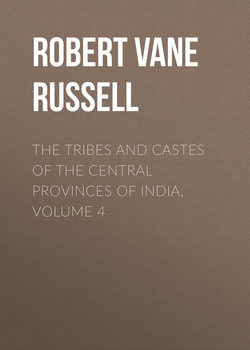Читать книгу The Tribes and Castes of the Central Provinces of India, Volume 4 - Robert Vane Russell - Страница 84
Part II
Articles on Castes and Tribes
Kumhār—Yemkala
Vol. IV
Kurmi
45. The cultivating status
ОглавлениеThe social status of the Kurmi appears to be that of the cultivator. He is above the menial and artisan castes of the village and the impure weaving and labouring castes; he is theoretically equal to the artisan castes of towns, but one or two of these, such as the Sunār or goldsmith and Kasār or brass-worker, have risen in the world owing to the prosperity or importance of their members, and now rank above the Kurmi. The Kurmi’s status appears to be that of the cultivator and member of the village community, but a large proportion of the Kurmis are recruited from the non-Aryan tribes, who have obtained land and been admitted into the caste, and this tends to lower the status of the caste as a whole. In the Punjab Kurmis apparently do not hold land and are employed in grass-cutting, weaving, and tending horses, and are even said to keep pigs.83 Here their status is necessarily very low as they follow the occupations of the impure castes. The reason why the Kurmi as cultivator ranks above the village handicraftsmen may perhaps be that industrial pursuits were despised in early times and left to the impure Sūdras and to the castes of mixed descent; while agriculture and trade were the occupations of the Vaishya. Further, the village artisans and menials were supported before the general use of current coin by contributions of grain from the cultivators and by presents of grain at seed-time and harvest; and among the Hindus it is considered very derogatory to accept a gift, a man who does so being held to admit his social inferiority to the giver. Some exception to this is made in the case of Brāhmans, though even with them the rule partly applies. Of these two reasons for the cultivator’s superiority to the menial and artisan castes the former has to a large extent lost its force. The handicrafts are no longer considered despicable, and, as has been seen, some of the urban tradesmen, as the Sunār and Kasār, now rank above the Kurmi, or are at least equal to him. Perhaps even in ancient times these urban artificers were not despised like the village menials, as their skill was held in high repute. But the latter ground is still in full force and effect in the Central Provinces at least: the village artisans are still paid by contributions from the cultivator and receive presents from him at seed-time and harvest. The remuneration of the village menials, the blacksmith, carpenter, washerman, tanner, barber and waterman is paid at the rate of so much grain per plough of land according to the estimated value of the work done by them for the cultivators during the year. Other village tradesmen, as the potter, oilman and liquor-vendor, are no longer paid in grain, but since the introduction of currency sell their wares for cash; but there seems no reason to doubt that in former times when no money circulated in villages they were remunerated in the same manner. They still all receive presents, consisting of a sowing-basketful of grain at seed-time and one or two sheaves at harvest. The former are known as Bījphuti, or ‘the breaking of the seed,’ and the latter as Khanvār, or ‘that which is left.’ In Bilāspur the Kamias or village menials also receive as much grain as will fill a winnowing-fan when it has been threshed. When the peasant has harvested his grain all come and beg from him. The Dhīmar brings waternut, the Kāchhi or market-gardener some chillies, the Teli oil and tobacco, the Kalār some liquor if he drinks it, the Bania some sugar, and all receive grain in excess of the value of their gifts. The village menials come for their customary dues, and the Brāhman, the Nat or acrobat, the Gosain or religious mendicant, and the Fakīr or Muhammadan beggar solicit alms. On that day the cultivator is like a little king in his fields, and it is said that sometimes a quarter of the crop may go in this way; but the reference must be only to the spring crop and not to the whole holding. In former times grain must have been the principal source of wealth, and this old custom gives us a reason for the status of the cultivator in Hindu society. There is also a saying:
Uttam kheti, madhyam bān,
Kanisht chākri, bhīk nidān,
or ‘Cultivation is the best calling, trade is respectable, service is menial, and begging is degraded.’
83
Punjab Census Report (1881), p. 340.
